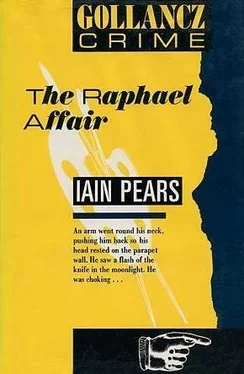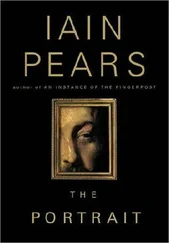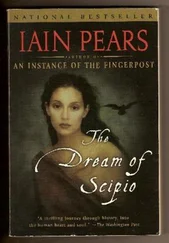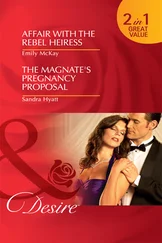Iain Pears - The Raphael Affair
Здесь есть возможность читать онлайн «Iain Pears - The Raphael Affair» — ознакомительный отрывок электронной книги совершенно бесплатно, а после прочтения отрывка купить полную версию. В некоторых случаях можно слушать аудио, скачать через торрент в формате fb2 и присутствует краткое содержание. Город: London, Год выпуска: 1990, ISBN: 1990, Издательство: Victor Gollancz, Жанр: Исторический детектив, на английском языке. Описание произведения, (предисловие) а так же отзывы посетителей доступны на портале библиотеки ЛибКат.
- Название:The Raphael Affair
- Автор:
- Издательство:Victor Gollancz
- Жанр:
- Год:1990
- Город:London
- ISBN:978-0-575-04727-3
- Рейтинг книги:3 / 5. Голосов: 1
-
Избранное:Добавить в избранное
- Отзывы:
-
Ваша оценка:
- 60
- 1
- 2
- 3
- 4
- 5
The Raphael Affair: краткое содержание, описание и аннотация
Предлагаем к чтению аннотацию, описание, краткое содержание или предисловие (зависит от того, что написал сам автор книги «The Raphael Affair»). Если вы не нашли необходимую информацию о книге — напишите в комментариях, мы постараемся отыскать её.
The Raphael Affair — читать онлайн ознакомительный отрывок
Ниже представлен текст книги, разбитый по страницам. Система сохранения места последней прочитанной страницы, позволяет с удобством читать онлайн бесплатно книгу «The Raphael Affair», без необходимости каждый раз заново искать на чём Вы остановились. Поставьте закладку, и сможете в любой момент перейти на страницу, на которой закончили чтение.
Интервал:
Закладка:
To help Anderson in the right direction, Flavia began telling him about the scientific study of the picture. The scientist waved her aside. ‘I know all this. I was in charge.’
‘I thought Manzoni was?’
‘Him?’ Anderson said contemptuously. ‘He never came near it. Just read the report afterwards, said he was sure we’d done it all correctly, and signed the thing. Scarcely lifted a finger.’
Flavia was quite unjustifiably irritated at the aspersions cast on her fellow-countryman by this large and cocky Englishman. His comments smacked too much of anti-Italian prejudice for her taste. Moreover, it meant one of her pet theories was weakened. If Manzoni hadn’t directed the tests, he couldn’t have fixed them either. Her focus came back to Anderson, who was pronouncing at great length, not noticing she hadn’t been paying any attention.
‘...That’s why I’d like to hear your evidence. I can’t see any way that picture could be a fake. It looked right and tested right. The evidence would have to be absolutely overwhelming to make me change my mind,’ he concluded.
She evaded again. ‘Just tell me, how would someone fake a thing like that?’
‘In principle it’s easy. It’s just doing it that’s the trouble. From what I remember of the report, the forger would have had to get hold of a sixteenth- or late fifteenth-century canvas to start off with. One the right size as the final picture so there wouldn’t be any new strain marks from the new shape of the stretcher. You clean off some, but not all, of the original paint. Then you start painting your own picture, using the same techniques and the same paint recipes as the original artist.’
Flavia nodded. So far what he was saying fitted in exactly with the jottings in the Swiss sketchbooks.
‘Once you’ve painted it, then it has to be artificially dried and aged. An oil painting takes years to dry completely, sometimes half a century. There’s no bigger giveaway than a Renaissance picture which is sticky. That, incidentally, is how Wacker, the Van Gogh forger, got caught in the 1930s.
‘Drying can be done in several ways,’ he continued. ‘The traditional method is to bake it — preferred temperatures vary from forger to forger — then roll it up in several directions to crack the surface, then dip it in a solution of ink to darken the cracks and make them look dirty. That, at least, was the Van Meegeren method, and he was one of the greatest. Couldn’t paint for tuppence, but a great forger.
‘Of course, there are ways of checking all that. The Elisabetta was analysed for the way it had dried, the direction and type of the cracking were examined, bits of paint were scraped off and tested in a dozen different ways, the dirt boiled up and analysed chemically. All perfect, as I say.’
‘So you’ve told us how to get caught. How about not getting caught?’ Argyll suggested.
‘There are some ways, I suppose,’ Anderson replied reluctantly. ‘As far as drying goes, you might try a low-voltage microwave oven, perhaps. That would produce a different method of drying out. Not foolproof, by any means, but it wouldn’t produce the tell-tale signs one looks for to indicate normal baking. Cracking is also relatively simple if you are careful to preserve the original pattern on the host painting. Doing it is incredibly hard, but it is possible.
‘In the case of the Raphael, you could dissolve the dirt from the original painting in some solution of alcohol and spread that over the surface. When it was tested it would be seen as being of a mixture of different substances, which is what it should be. The alcohol would also show up, but in this case might be confused with the substances we used to clean the thing.
‘But it’s paint itself which proves it. It’s difficult to see how to get round that, and we tested it endlessly. Spectroscope, electron microscope, dozens of different routines. There can be no doubt. It was sixteenth-century, Italian, painted with Raphael’s techniques. Genuinely old paint. Not just new paint mixed with old recipes. Old paint. Everything worked out perfectly. Which is why I don’t really believe it was a fake.’
‘I know how it was done,’ said Argyll quietly. They both looked at him. ‘It’s just occurred to me. Flavia, you told me the tests on the paint were done from a thin, long strip from the left-hand side of the picture?’ She nodded.
‘So why couldn’t the painter have left that bit from the original sixteenth-century picture? Paint over the central portion and match the background and portrait up. Then you could test to your heart’s content, and the tests would have been positive every time.’
‘Is that possible?’ Flavia asked Anderson.
He considered the matter. ‘Technically, I suppose so. Of course it would be a bit difficult to hide the joins from X-rays, but that might be done if you add a small amount of metallic salt to blur the picture. If I remember, there was some blurring, but we were in a hurry, it was a new machine, so everyone assumed it was just a glitch. The real problem with that interpretation is how could any forger be sure the right bit of paintwork was tested?’
‘That was no trouble at all. You were told to test that bit, weren’t you? And who told you, eh?’
‘The museum did.’
‘You spoke to the museum yourself? They wrote to you?’
‘No. Sir Edward told us. He said the museum didn’t want any damage...’
‘Aha.’ Argyll leaned back in his chair once more, crossed his arms and nodded at Flavia. ‘There you are. Problem solved. Glad you brought me now?’
Argyll was in an excellent mood as he wandered round shops and libraries the next day, collecting the final bits and pieces he needed. In truth, the previous evening had been a triumph. Not only had he put that insufferable restorer in his place and come up with a nifty idea to prove Byrnes’s guilt, he had compounded the achievement by giving Flavia his startling news as they walked back to the hotel she had chosen. He had, he told her, found the picture.
She was impressed. No doubt about it. Of course, she did insist on asking awkward questions like where was it? how had he tracked it down? and things like that. But he managed to sidestep those, saying mysteriously that she’d have to wait and see. That irritated her, but he stuck to his position. After all, he wasn’t quite as sure as he’d implied.
So, whistling contently to himself, Argyll flitted in and out of art supply shops, accumulating equipment; and visited the literary-memoir, travel and history sections of the London Library, gathering an impressively filled plastic bag of possessions.
He looked at his watch. Eleven o’clock. Ten minutes to go, a brief visit to Byrnes as he’d arranged by telephone earlier that day, then back to Rome on the two o’clock flight. Perfect. He began to feel he was quite good at this sort of thing.
Inside the Byrnes Gallery he gave his name to the assistant, mentioned he had an appointment, and looked at the pictures while he waited. Five minutes later he was ushered into Byrnes’s inner sanctum and shown to a seat. He declined the offer of a cup of coffee.
‘Jonathan. I didn’t know you were back in London quite so soon. How can I help you?’ Byrnes smiled gently over the half-moon glasses he used for reading. Argyll disliked them; they always gave the wearer the opportunity to peer over them at you as if he was looking at some anatomical specimen. Very affected.
‘Hardly at all,’ he said. ‘I was just passing so thought I’d drop in and say hello. Just to let you know I was around.’ He smiled inanely. He’d always been told he overdid the foolish look, but it came in decidedly useful now.
‘And why are you around? I thought you would be hard at work in Rome by now. Or have you been roped into this Raphael business as well?’
Читать дальшеИнтервал:
Закладка:
Похожие книги на «The Raphael Affair»
Представляем Вашему вниманию похожие книги на «The Raphael Affair» списком для выбора. Мы отобрали схожую по названию и смыслу литературу в надежде предоставить читателям больше вариантов отыскать новые, интересные, ещё непрочитанные произведения.
Обсуждение, отзывы о книге «The Raphael Affair» и просто собственные мнения читателей. Оставьте ваши комментарии, напишите, что Вы думаете о произведении, его смысле или главных героях. Укажите что конкретно понравилось, а что нет, и почему Вы так считаете.












